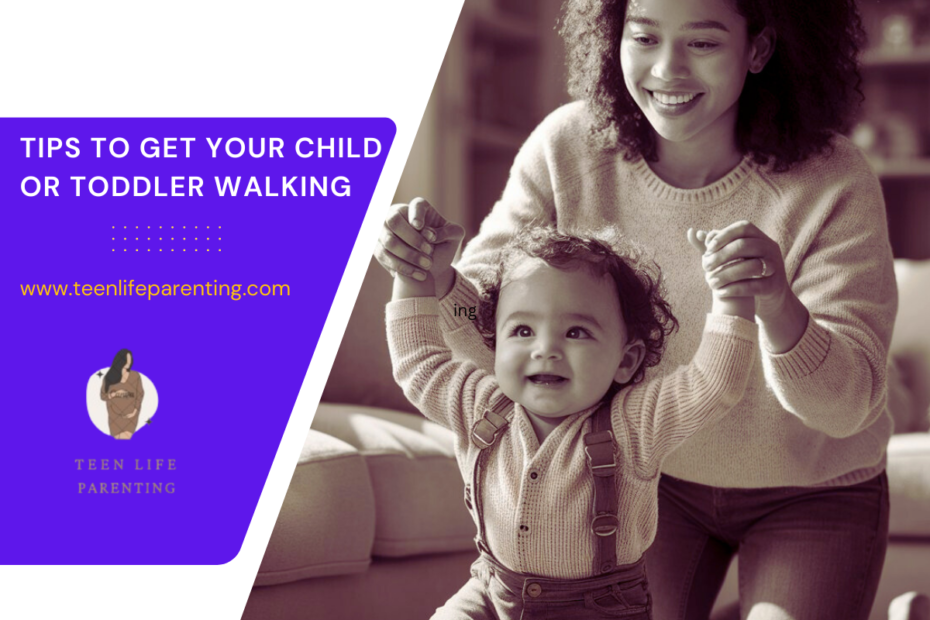Hi there, parents! Welcome to my blog about being a parent. My name is Donna. We’ll talk about how to help your baby take their first step in this post.
Did you know that most toddlers take their first steps between 9 and 15 months old?
Teaching your child to walk is a rewarding journey that requires patience and a step-by-step approach.You can help them grow by giving them a safe place to be and encouraging their natural interest.
Before we start let’s learn this thing first…
When do babies start walking?
Babies usually start walking around 8 to 12 months, but keep in mind that every child is different when it comes to this important milestone. Learning about the steps of walking can help you help your child as they get better.
At first, they might pull themselves up to stand with help. Then, they might get better at standing on their own and moving along furniture. These steps are very important for building muscle and confidence.
The key is making settings that are supportive. Make sure your house is safe and easy to get around in. To get your baby to take those first steps, you might want to put toys just out of reach.
Also, sensory input is very important. Let your child play on different surfaces to improve their balance and coordination.
Keep calm and know that it takes time to learn how to walk. No matter how small the accomplishment, you should be proud of it. Also, focus on your child’s strengths while gently addressing any flaws.
Also, keep in mind that each child may grow at a different rate. Some may walk sooner than others. Your support and understanding will help them have a good time as they start this amazing trip to walking with confidence.
Gross Motor Development Chart
Okay So what is meant by Gross Motor Development Chart?
Gross motor skills, also called physical skills, involve moving the whole body and using the body’s big, core-stability muscles to do everyday things like standing, walking, running, and sitting up straight. Also included are skills that use both hands and eyes together, like throwing, catching, and hitting a ball.
| Age Range | Gross Motor Skill |
|---|---|
| 0-3 months |
|
| 3-6 months |
|
| 6-9 months |
|
| 9-12 months |
|
| 12-18 months |
|
| 18-24 months |
|
| 2-3 years |
|
| 3-4 years |
|
| 4-5 years |
|
According to this chart, you can decide what your toddler is capable of with.
Now let’s talk about 15 step by step tips to Get Your Baby or Toddler Walking..
15 Step-By-Step Guide to teaching your baby/toddler to walk
To help your toddler take those first steps, you’ll want to focus on key developmental stages.
Start by encouraging tummy time and supporting their sitting and crawling skills, as these build a strong foundation for walking. As they gain confidence, assist them with standing and facilitate cruising to make walking a natural next step.
1. Encourage tummy time
Your toddler’s core strength and movement skills will benefit greatly from tummy time, so make it a fun and interesting part of their daily routine.
Put colorful toys within reach during tummy time to encourage sensory discovery. This keeps them busy and helps them improve their small motor skills as they reach and grab.
During tummy time, you can connect it to the season by using things that are appropriate for that season, like beach toys in the summer and pumpkins in the fall.
Here are some ways to make belly time more fun:
- Use a play mat with different textures to stimulate their senses.
- Incorporate outdoor activities by laying a blanket on the grass for a fresh experience.
- Engage in language development by talking to them or reading a book while they’re on their tummy.
- Rotate toys regularly to keep their interest piqued.
2. Support sitting
An important initial step in your toddler’s walking path is helping them to sit since it develops the core strength and balance required to take those first confident steps.
First make sure your child sits correctly. Use floor cushions to create a pleasant and supporting surroundings. Urge children to sit straight, therefore strengthening their sitting balance.
Placing toys within reach will also help sitting to be more interesting by motivating kids to lean and reach while preserving core strength. If they start to wobble as they practice, gently help them to sit correctly without taking away their independence.
3. Promote crawling
All of this helps build moving muscles, which usually happen between seven and ten months. they might rock back and forth on her knees sometimes. Since her arms are bigger than her legs, she might push herself backward. With practice, she’ll be able to move across the room and reach her goal.
Some kids never learn to crawl. Their other way of getting around is to slither on their stomachs or bottoms. Your baby should be able to organize her arms and legs and use them equally. She needs to learn more about her surroundings and get stronger so she can walk. Talk to your child’s doctor if they aren’t moving regularly.
4. Assist with standing
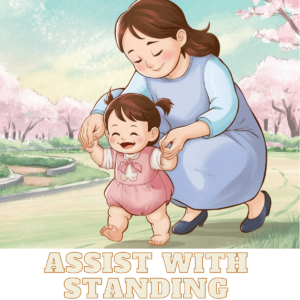
Now let’s move to next important step…Standing.
Make sure your child has a safe place to practice balancing with few distractions so they can learn to stand. Clear the space of things that can fall over and give them stable furniture to lean on.
Get them to sit on a stool with their feet on the floor to begin. This position makes them more stable and helps build their core. The next step is to get them to reach for toys that are just out of reach. This will help them improve their balance and keep their muscles active.
As they get stronger, hold their trunk up while they try to stand on their own. Make sure they’re supporting themselves by putting their feet under their bodies. This is an important step toward becoming independent. To get them to move their weight and work on their balance, give them light toys.
Don’t forget to be patient and enjoy the little wins. Your child is getting closer to walking every time they can stand up on their own. By letting them try out different positions and moves, you can help them quickly learn how to stand on their own, which will set them up well for when they start walking.
5. Go barefoot
For early walks, you don’t need shoes. At first, letting your child play barefoot might be good for them.
Babies learn a lot from their feet as they learn to walk. How their brain handles their muscles and joints changes when they walk on hardwood, carpet, or grass.
Check for anything that could hurt your baby’s feet (see step 1) before letting them walk around without shoes.
Why it’s good: You could call it proprioceptive input. Your baby’s shoes might change how they see the ground. Walking barefoot also makes the muscles in your feet stronger, which makes you more stable.
6. Provide push toys
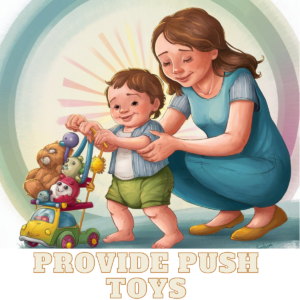
You should give your child a strong push toy. this can help them learn to walk by keeping them stable and balanced as they take their first steps.
When choosing toys for your child, look for ones that are sturdy, light, and easy to control. This will make them want to practice standing and will boost their confidence as they get better.
Allow your child to use push toys both inside and outside.
To improve your power and coordination, do exercises that have you squat and reach. As they learn, give them more difficult push toys to keep them busy.
7. Create a safe space to walk
Giving your baby a safe place to play while they learn to walk is important for their growth and confidence.
They can practice their new skills without worrying about getting hurt if the area is well-prepared.
8. Hold their hands
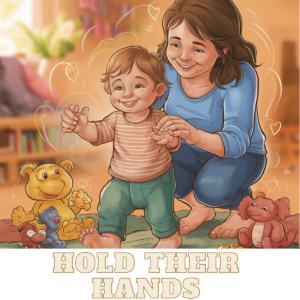
Okay, so this step is most important and trustworthy…
Holding your baby’s hand as they take their first steps will help them feel more confident and give them support as they walk. During this stage, your involvement as a parent is very important to build safety.
First, hold your child’s hands in front of you firmly but softly. With this walking aid, they can work on hand-eye balance while they learn how to move.
Tell your child to move their weight from one foot to the other to get their leg joints moving. As they gain speed, tell them to look ahead to boost their confidence.Celebrating their small wins will help them stay determined.
During these times, take part in fun conversations. Make it into a game where they come to you for a good time. It makes you stronger physically and strengthens your bond.
9. Gradually reduce support
As your child gets better at walking, you can slowly take your hand off of them, letting them practice their balance and coordination with each step. This stage is very important for helping them become more independent over time. As they learn to believe in their own skills, they will make steady progress.
To start, support their upper body instead of holding their hands. This will let them move more easily.
If you stand far away and ask them to walk toward you, that will help them practice being steady. To get them going, use toys or other items that will make the activity fun and interesting.
10. Motivation and Support
When your child takes their first steps, giving them praise can really boost their confidence. Make sure to praise and cheer them on for every accomplishment, no matter how small. Set up a way to thank them for tracking their progress, like stickers or special treats, to keep them going.
11. Set up mini obstacles
Now if you follow all the step and your child is doing well now its time to add some little obstacles.
Make a small obstacle course in your living room to keep your child interested and excited while they practice walking. This fun set-up not only gets kids moving, but it also helps them improve their balance and motor skills.
Include different things that will test your child and give them sensory experiences.
Here are some ideas to get you started:
- Cushions and pillows: Create soft barriers to navigate around or over.
- Tunnels: Use a cardboard box or play tunnel for crawling and walking through.
- Low furniture: Encourage cruising along sofas or coffee tables to build confidence.
- Textured paths: Lay out different materials like rugs or mats for varied sensory experiences.
12. Climb the stairs
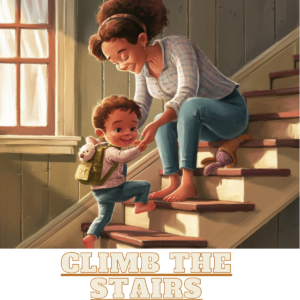
When what’s happening on the floor gets old, move the show to the stairs. It goes without saying that being close to your baby is the best way to do this. Do not help your child climb the stairs. Let them use their hands, knees, etc. This practice works every muscle group in your body.
If your house doesn’t have stairs, you can use a ramp instead.
You can get a foam ramp that helps with basic motor skills for about $100. It can be used for a number of different things.
Climbing stairs is good for babies because it helps them build stronger leg and body muscles. Besides that, it makes something possible called “lower body dissociation.” Now there are signs that your baby can tell the difference between movements of the upper and lower parts.
13. Play standing games
Playing games where your child has to stand can make learning to walk more fun and interesting while also helping them get stronger and more balanced.
Not only do these tasks improve your sense of space, they also get you to try out new things with your senses. Try giving your child a range of games that will keep them interested and help them grow.
14. Get baby’s to stand up and squat
Set up your toddler’s best toys at different heights to get them to squat and stand, which will help them build strength and balance. To help kids build core strength and muscles through balance activities, have them kneel down to pick up toys.
Show your child the right way to lift things and stand up straight when they do so. As they practice going up and down, gently push them and hold their sides.
Change how the toys are set up to keep things fun and interesting for your child. Standing and squatting will help you walk by making your legs and core stronger.
15. Encourage them to Move on Music
If your child doesn’t want to just stand there, get them to dance and listen to music. Children enjoy moving to music, so play some songs or make up a beat and let your child dance.
Dance and music make working out their legs and core fun, and we all know that children love having fun. Also, it makes them use some of their endless energy.
16. Be patient and consistent
As your child takes their first steps toward walking, remember that you need to be patient and consistent.
This will help them build strength and balance. Because you are the parent, you need to be involved in making the space where your child feels safe to discover encouraging.
Make a regular schedule for them so they know when to work on their walking.
Things you shouldn’t do when teaching your baby to walk
Don’t ever force your baby to walk, Even though your child may show signs of being ready, it could take a while for the brain and body to fully connect.
Baby strollers might look like a good idea on paper, but they are very dangerous. Wheels and push toys are not the same.
These things are used to sit in instead of stand behind by babies. The wheels on the bottom let your child push off with their feet and the toys roll around easily.
Even though it would be fun to hear, imagine putting a baby in something that doesn’t make sense. This lets a baby who can’t move move around the room at a normal speed.
Sadly, babies in walkers have fallen down stairs, rolled into pools when no one was watching, burned themselves on electrical outlets, and even picked up heavy or hot things off of tables.
The AAP (Trusted Source) also says that people shouldn’t use walkers because of these risks. Also, they haven’t been shown to help people walk. When used on babies, they can sometimes make them move funny, like toe-walking.
What is Considered Late Walking?
Let’s deal with this fact, Most toddlers walk between the ages of 11 to 16 months.
Late walking is between 18 and 20 months (or beyond).
However, it’s important to note when your child met their other milestones. If she started to sit independently later than average, it goes to reason that walking would be later as well. As long as there is a steady progression of milestones, most doctors aren’t too worried with late walking.
However, if your child met all of their other milestones at the traditional timing and a large gap exists between those and walking, your doctor may want further investigation, especially after the age of 20 months.
When would you start to worry that a toddler wasn’t walking?
The CDC(Centers for Disease Control and Prevention ) says that you should tell your doctor if your baby isn’t walking by 18 months. But it’s not always a problem even then. Babies sometimes need help getting up.
Your child’s doctor may tell you about Early Intervention in your state. If not, you don’t need a recommendation. Just call your local program and say, “I’m worried about my child’s development and would like to have them checked out to see if they qualify for early intervention services.”
Anyone who is 16 to 23 months old and hasn’t learned to walk should take their baby to the doctor. The baby’s muscle strength, range of motion, and joint flexibility should all be checked during this test. Taking too long to walk could be an early sign of cerebral palsy, muscle dystrophy, or other diseases that run in families.
Final Thought
Dear Parents, As you teach your child to walk, you need to be there for them every step of the way.
Don’t forget that each child grows and learns at their own pace, so be gentle and consistent.Give them a safe place to explore and celebrate their small wins.
They’ll get stronger and more sure of themselves with your help. Your child will soon be able to walk happily and be ready to discover the world around them.
Keep showing them the way, and see how well they do!
Medically reviewed by Melisa Gray M. Moyer, MD, Internal Medicine, Pediatrics, Hospice and Palliative Medicine — Written by Donna Smith on August 07,204

As a mom of teens and a pediatric Psychologists, I struggled to build trust. Through openly sharing my ups and downs raising two independent-minded kids, I provide practical tips to improve communication and confidently guide your teens into adulthood.
